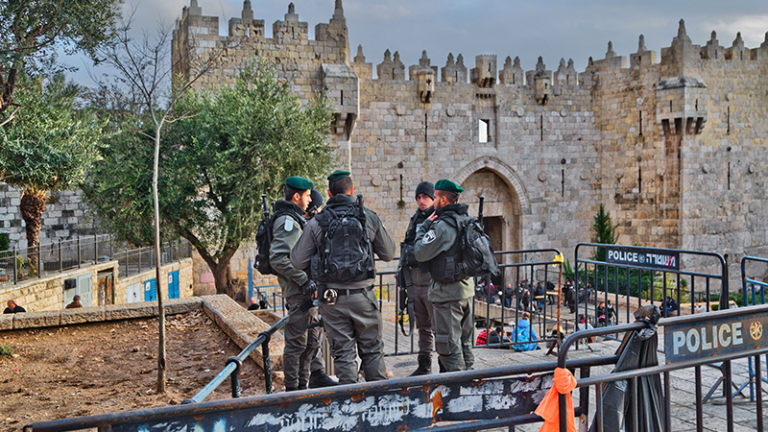
Ramadan, the Islamic holy month, is a cherished time for hundreds of millions across the globe, featuring fasting, reflection, recitation of religious verse, and family gatherings. In 2021 in Palestine, it was also the setting for one of the largest and most significant Palestinian mobilizations in recent memory. As Ramadan begins anew this year, it is important to recall the steps that led to the events of May 2021 and assess the likelihood of a recurrence.
How Restrictions and Repression Set the Stage in 2021
Perhaps one event from Palestine in May of 2021 that most will remember was the Israeli bombing and destruction of the al-Jalaa tower in Gaza City. The strike was something of a turning point because the tower was not only a civilian building and not a legitimate military target, but it also housed the offices of Al Jazeera and the Associated Press. The sensational video of the highrise collapsing sent shockwaves around the world and was seen as an attack on journalists. This attack also gave those who were hesitant to defend Palestinians an opportunity to speak up and call for a ceasefire, since western journalists were clearly at risk as well. This strike, a clear Israeli own goal, led to a public relations debacle between Israel and the United States as Secretary of State Antony Blinken denied seeing any evidence that Hamas was using the building and asked Israel for justification for the bombing. Israeli officials claimed to share evidence of the tower being a legitimate target with US officials, but these never confirmed the claim.
Before the strike on al-Jalaa tower in Gaza, and before Israel began another bombing campaign there, the heart of the uprising was taking place in Jerusalem, building toward a fever pitch throughout the month of Ramadan.
But before the strike on al-Jalaa tower, and before Israel began another bombing campaign of Gaza, the heart of the uprising was taking place in Jerusalem, building toward a fever pitch throughout the month of Ramadan. Part of it was the struggle of Palestinian families in the Sheikh Jarrah neighborhood, just outside the old city, who were facing impending expulsion from their homes by the Israeli state to make way for Israeli settlers. Sheikh Jarrah and the expulsions strike a particularly sensitive chord for Palestinians. Jerusalem is the city at the center of the Palestinian national ethos and Palestinians there have been under constant threat of expulsion and discrimination. The act of forced expulsion itself is also deeply resonant in Palestinian memory as the core encounter with settler colonialism.
Expulsions, however, have happened before and, of course, too often. What made this particular moment different was a series of concurrent and repressive actions in and around Jerusalem targeting Palestinians and their access to the holy city during the month of Ramadan.
Restrictions on Jerusalem were not new, and Palestinians had long been denied access to the city by an infrastructure of walls and checkpoints that prevent entry to anyone who didn’t have a military permit from Israeli occupation forces. But restrictions inside the city itself, especially concerning religious worship and during the holy month, brought tensions to a different level. Indeed, the month started off ominously as the first day coincided with Israel’s commemoration of fallen soldiers in Jerusalem. As was reported at the time, “Israeli police broke locks and cut the electric lines to the loudspeakers at four minarets in Jerusalem’s Al-Aqsa Mosque… silencing evening calls to prayer the first day of the Islamic holy month of Ramadan.”
Israeli police also took the step of closing off the steps to the Damascus Gate during the early days of the holy month. This gate to the old city is perhaps its most famous, as is its spacious plaza which has long served as a gathering place for Palestinians during Ramadan evenings. The extended closure of this space during Ramadan was unprecedented and was seen as a deliberate attack on Palestinian worshipers.
To fully understand the effect of closures on Palestinians, one must see them in the context of the Palestinian experience in Jerusalem and more broadly.
To fully understand the effect of these closures on Palestinians, one must see them in the context of the Palestinian experience in Jerusalem and more broadly: a never-ending closure of space and access increasingly separating a people from the land they’ve always called home. The pending expulsions from Sheikh Jarrah only further accentuated this and police continuously responded to protesters there with repression during a month of fasting.
Tensions continued to rise in the city as Israeli settlers marched in the city, chanting “death to Arabs.” Israeli police raided the Al-Aqsa Mosque on several nights, including on Laylat al-Qadr, when, Muslims believe, the first verses of the Quran came to Prophet Mohammed. This was perhaps the last straw as it began the largest Palestinian mobilizations in response across the entire country, including inside the Green Line, as well as retaliation from militant factions in Gaza.
The confluence of events that brought about last year’s uprising were unique. These included not just the dynamics around Sheikh Jarrah and the closing space in Jerusalem during Ramadan, but also the political situation in Israel at a time when a governing coalition was in the delicate process of being formed. While these exact conditions are not in play again this year, there is no shortage of the embers of apartheid that are perpetually hot and require little fuel to run ablaze again.
The 2022 Indicators
When it comes to provocations and closing space in Jerusalem, signs for this year have been ominous ahead of Ramadan. In early March, about a month before Ramadan, Palestinians marked Al-Isra’ wal-Mi’raj, which in the Islamic tradition marks Prophet Mohammed’s night visit to heaven from Jerusalem before returning to Mecca. Some 90,000 Palestinians are thought to have come to Jerusalem’s old city to mark the occasion and the day ended with an Israeli police crackdown on scores of worshipers. As it was reported, “two people were arrested and around 31 were injured, with Israeli forces using skunk water, stun grenades and rubber-coated bullets to disperse Palestinians.”
At the same time, the far-right Israeli Knesset member Itamar Ben-Gvir (leader of the Jewish Power Party, Otzma Yehudit) planned a rally that was approved by the government to Sheikh Jarrah. They massed around the home of the Salem family, which is also facing expulsion from the neighborhood, and attacked.
Events under Israeli occupation a month before Ramadan showed how quickly different factors could come together to bring an already volatile situation to a more intense level.
Events under Israeli occupation a month before Ramadan showed how quickly different factors could come together to bring an already volatile situation to a more intense level. These were likely some of the events that were in mind when Israeli and Jordanian officials met several times in recent months, including a meeting between King Abdullah II and the Israeli Defense Minister Benny Gantz. Jordan plays a special role as a caretaker of the Noble Sanctuary compound and has emphasized the need for Israel to prevent provocations.
Yet just as Ramadan started, Israeli authorities once again clashed with Palestinians at Damascus Gate and arrested ten people. Serial provocateur Itamar Ben-Gvir had also entered the Noble Sanctuary compound on March 31 with an Israeli police escort in a move seemingly designed only to elevate tensions. Ben-Gvir is a follower of the late Meir Kahane and keeps a photo of Baruch Goldstein in his home. Goldstein, another Kahane disciple, massacred 29 Palestinian worshippers at the Ibrahimi Mosque in Hebron in 1994.
Most recently, the Israeli Foriegn Minister and soon to be Prime Minister Yair Lapid, made a visit with a police escort to the Damascus Gate. Lapid, who has the largest share of seats in the current governing coalition, entered into a rotational agreement with kingmaker Naftali Bennett after last May’s uprising. The agreement calls for Bennett to hold the premiership first and then rotate with Lapid two years into their term and assume the Foreign Ministry. Lapid is eyeing his opportunity at the premiership and elevating his profile. Most recently he was at center stage during an unprecedented high-profile summit in the Negev with the Foreign Ministers of Arab states that normalized with Israel, including the United Arab Emirates, Morocco, Egypt, and Bahrain, along with US Secretary of State Antony Blinken. Lapid’s visit in Jerusalem was criticized as provocative by Gantz, who is a coalition partner and defense minister.
In their own ways, various Israeli political figures are hoping to use the moment to burnish their credentials ahead of what may be another election season in Israel if the rotation agreement between Lapid and Bennett falls through. Indeed, a fresh sign of the government’s dreaded collapse came with the resignation on April 6 of Idit Silman, a member of Bennet’s rightwing party, which robbed the cabinet of its razor-thin parliamentary support.
What to Watch
As we move through the month of Ramadan, there are several factors worth watching closely. These could quickly change a tense situation on the ground into a chaotic and deadly one in Jerusalem and beyond.
Provocations by Israeli political figures: Whether it is politicians looking to be seen ahead of their next political steps, like Lapid, or pyromaniacs, like Ben-Gvir, who are seeking to set off chaotic violence, provocations by Israeli political figures or their followers at this time are especially dangerous. Israeli authorities have a choice over whether or not to permit these provocations, but so far have not prevented them; if anything, they facilitated them. Current conditions continuing as the month progresses would only add fuel to the fire.
Israeli violations in and around the old city: Last year, there were pending expulsions in Sheikh Jarrah, but that is only one neighborhood where Israel could take action around the old city to force Palestinians from their homes, conduct raids and arrests, or even execute punitive demolitions of homes. Again, Israeli authorities here have a choice about how to proceed. Should the same old repressive measures be employed, they will clearly have chosen to act with disregard for the volatility that would surely follow.
Closure of space and access around holy sites: Restrictions around Damascus Gate in Jerusalem are ominous signs that suggest that Israeli authorities have not learned the lessons of last year about how provocative these measures are precisely at a moment when Palestinians seek to spend time together in and around the holy city. Will these restrictions remain or even grow? Will they go beyond the gate and extend to the Noble Sanctuary compound as well? In recent years, metal detectors near the compound set off a firestorm of protest against Israeli limits on Palestinian freedom of movement. Repeating old tactics will most likely lead to the same outcome.
The denial of equitable access to any community would stand out as a serious slight.
Overlapping holidays and the last week of Ramadan: Despite operating on several different religious calendars, fate has it that this year the month of Ramadan overlaps with the Jewish Passover holiday (April 15-23), the Catholic Easter (April 17), and the Eastern Orthodox Easter (April 24). This means that the vast majority of the city’s religious communities may be seeking access to the holy sites at similar times. The denial of equitable access to any community would stand out as a serious slight. In 2021, the situation escalated significantly when Israeli police raided the Al-Aqsa Mosque during the particularly important last days of Ramadan.
While last year’s unique circumstances are not the same today, this year brings its own unique conditions. Additionally, last year’s lessons remain quite relevant. The extent to which this Ramadan in Jerusalem remains a peaceful month of worship or a volatile month of protest and repression depends heavily on the choices Israeli authorities make in their treatment of Palestinians in the holy city of Jerusalem and beyond.

